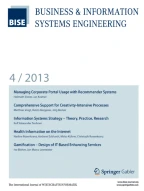Abstract
Enterprises have a large amount of data available, represented in different formats normally accessible for different specialists through different tools. Integrating existing data, also those from more informal sources, can have great business value when used together as discussed for instance in connection to big data. On the other hand, the level of integration and exploitation will depend both on the data quality of the sources to be integrated, and on how data quality of the different sources matches. Whereas data quality frameworks often consist of unstructured list of characteristics, here a framework is used which has been traditionally applied for enterprise and business model quality, with the data quality characteristics structured relative to semiotic levels, which makes it easier to compare aspects in order to find opportunities and challenges for data integration. A case study presenting the practical application of the framework illustrates the usefulness of the approach for this purpose. This approach reveals opportunities, but also challenges when trying to integrate data from different data sources typically used by people in different roles in an organization.
Similar content being viewed by others
Notes
References
Aasland K, Blankenburg D (2012) An analysis of the uses and properties of the Obeya. In: Proceedings of the 18th International ICE-Conference, Munich, 2012
Batini C, Scannapieco M (2006) Data quality: concepts, methodologies and techniques. Springer, Berlin
Batini C, Cappiello C, Francalanci C, Maurino A (2009) Methodologies for data quality assessment and improvement. ACM Comput Surv (CSUR) 41(3), article 16
Blackstone JH (2008) APICS dictionary. APICS, Athens
Chorafas DN (2005) The real-time enterprise. Auerbach, Boca Raton
Fox MS, Gruninger M (1998) Enterprise modeling. AI Mag 19(3):109–121
Grudin J (1994) Groupware and social dynamics: eight challenges for developers. Commun ACM 37(1):92–105
Hermans FFJ (2012) Analyzing and visualizing spreadsheets. PhD thesis, Software Engineering Research Group, Delft University of Technology, The Netherlands
Ingvaldsen JE (2011) Semantic process mining of enterprise transaction data. PhD thesis, NTNU, Trondheim
Jiang L, Barone D, Borgida A, Mylopoulos J (2009) Measuring and comparing effectiveness of data quality techniques. In: Proccedings of CAiSE 2009, pp 171–185
Kelle P, Akbulut A (2005) The role of ERP tools in supply chain information sharing, cooperation, and cost optimization. Int J Prod Econ 93–94:41–52
Kim J, Pratt MJ, Iyer R, Sriram R (2007) Data exchange of parametric cad models using ISO 10303–108, NISTIR 7433
Krogstie J (2008) Integrated goal, data and process modeling. In: Johannesson P, Søderstrøm E (eds) Information systems engineering from data analysis to process networks. IGI, Pennsylvania, pp 43–65
Krogstie J (2012) Model-based development and evolution of information systems: a quality approach. Springer, Berlin
Krogstie J (2013a) A semiotic framework for data quality. In: Proceedings of EMMSAD 2013, Valencia, pp 395–410
Krogstie J (2013b) Evaluating data quality for integration of data sources. In: Proceedings of PoEM 2013, Riga, pp 39–53
Krogstie J (2013c) Quality of conceptual data models. In: Proceedings of ICISO 2013, Stockholm, pp 168–176
La Rocca G (2012) Knowledge based engineering: between AI and CAD. Review of a language based technology to support engineering design. Adv Eng Inform 26(2):159–179
Lillehagen F, Krogstie J (2008) Active knowledge modeling of enterprises. Springer, Berlin
Lyons MH (2005) Future ICT systems – understanding the business drivers. BT Technol J 23(5):11–23
Manyika J, Sprague K, Yee L (2009) Using technology to improve workforce collaboration: what matters. McKinsey Digital
Martin N, Poulovassillis A, Wang J (2012) A methodology and architecture embedding quality assessment in data integration. ACM J Data Inf Qual 4(4), article 17
Moody DL (1998) Metrics for evaluating the quality of entity relationship models. In: Proceedings of the seventeenth international conference on conceptual modelling (ER ‘98), Singapore. Lecture Notes in Computer Science 16–19, pp 211–225
Moody DL (2005) Theoretical and practical issues in evaluating the quality of conceptual models: current state and future directions. Data Knowl Eng 55:243–276
Nelson HJ, Poels G, Genero M, Piattini M (2012) A conceptual modeling quality framework. Softw Qual J 20:201–228
Parush A, Hod A, Shtub A (2007) Impact of visualization type and contextual factors on performance with enterprise resource planning systems. Comput Ind Eng 52(1):133–142
Price R, Shanks G (2005) A semiotic information quality framework: development and comparative analysis. J Inf Technol 20(2):88–102
Recker J, Rosemann M, Krogstie J (2007) Ontology- versus pattern-based evaluation of process modeling language: a comparison. Commun Assoc Inf Syst 20:774–799
van Giressel N (2004) Process mining in SAP R/3. Master thesis, Eindhoven University of Technology, The Netherlands
Acknowledgments
The research leading to these results was done in the LinkedDesign project that has received funding from the European Union Seventh Framework Programme ([FP7/2007-2013]) under grant agreement n 284613.
Author information
Authors and Affiliations
Corresponding author
Additional information
Accepted after two revisions by the editors of the special focus.
Rights and permissions
About this article
Cite this article
Krogstie, J. Capturing Enterprise Data Integration Challenges Using a Semiotic Data Quality Framework. Bus Inf Syst Eng 57, 27–36 (2015). https://doi.org/10.1007/s12599-014-0365-x
Received:
Accepted:
Published:
Issue Date:
DOI: https://doi.org/10.1007/s12599-014-0365-x
